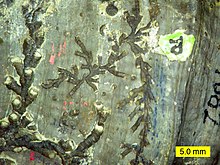Hederellid
| Hederellids/Hederelloids Temporal range:
| |
|---|---|

| |
| Branching colonies of hederellids[1] | |
| Scientific classification | |
| Domain: | Eukaryota |
| Kingdom: | Animalia |
| Phylum: | Phoronida (?) |
| Suborder: | †Hederelloidea Bassler, 1939 |
| Families and genera | |
|
See classification | |
Hederellids are
Classification
- Family Hederellidae
- Genus Diversipora
- Genus Hederella
- Family Reptariidae
- Genus Cystoporella
- Genus Hederopsis
- Genus Hernodia
-
Hederelloids encrusting a brachiopod from the Devonian of Ohio
-
SEM image of a hederelloid from the Devonian of Michigan (largest tube diameter is 0.75 mm)
References
- ^ Taylor, P.D.; Wilson, M.A (2008). "Morphology and affinities of hederelloid "bryozoans"" (PDF). In Hageman, S.J.; Key, M.M. Jr.; Winston, J.E. (eds.). Bryozoan Studies 2007: Proceedings of the 14th International Bryozoology Conference. Virginia Museum of Natural History. pp. 301–309. Archived from the original (PDF) on 2010-03-26. Retrieved 2011-03-26.
- ^ Bassler, R.S (1939). The Hederelloidea. A suborder of Paleozoic cyclostomatous Bryozoa. pp. 87:25–91.
{{cite book}}:|work=ignored (help) - ^ Wilson, Mark A.; Taylor, Paul D. ""Pseudobryozoans" and the problem of encruster diversity in the Paleozoic". PaleoBios (21 (supplement to no. 2)): 134–135.
- ^ Taylor, Paul D.; Wilson, Mark A. (2008). Hageman , S.J.; Key, M.M. Jr.; Winston, J.E. (eds.). Morphology and affinities of hederelloid "bryozoans" (PDF). Bryozoan Studies 2007: Proceedings of the 14th International Bryozoology Conference, July 1–8, 2007 (Special Publication 15 ed.). Boone, North Carolina. pp. 301–309. Archived from the original (PDF) on 2010-03-26.
- ^ Taylor, Paul D.; Olev Vinn; Mark A. Wilson (2010). "Evolution of biomineralization in 'Lophophorates'". Special Papers in Palaeontology. 84: 317–333.
Further reading
- Wilson, M. A.; Taylor, P. D. (2006). "Predatory drillholes and partial mortality in Devonian colonial metazoans". doi:10.1130/G22468.1.
- "Scientists Discover An Ancient Predator-Prey Relationship". College Of Wooster. 2006-07-13. Retrieved 2023-05-08.


